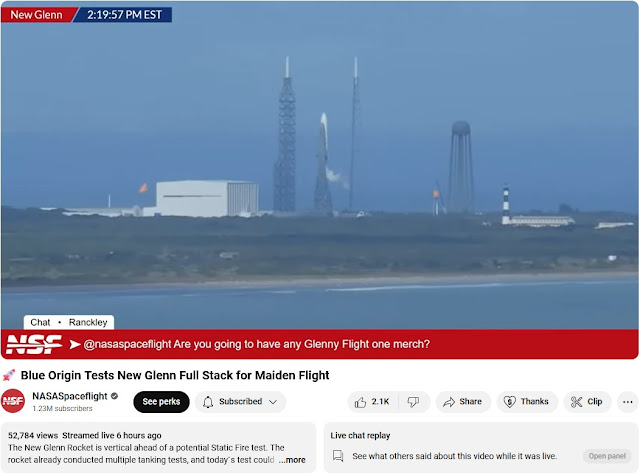Eric Berger at Ars Technica took on a pretty mundane topic over at Ars
Technica, but managed to blow my mind in the setup. The topic, the kind
that's always a matter of opinion, is to
rank the 25 coolest things in space so far in this century. The subtitle, though, is the thing that kicked me in the head:
“Taking stock of spaceflight one-quarter of the way through the 2000s.”
That's right, in three weeks, New Year's Day 2025, we're 1/4 of the way
through the 21st century. Sure, it's obvious when you think about it, I
just never gave a moment of thought to it.
It's an interesting read, far more interesting than the typical
end-of-the-year retrospectives we get every year for New Year's, and I
wouldn't dream of picking 25 things just to match the number of years but it
might be fun to think about the top 10 coolest things.
10: The Voyagers continue in interstellar space
I write about the two voyagers regularly, whenever a story comes up.
Pretty much every time, the problems are things never seen before.
Components are working at temperatures they never were certified for; and
that's true for every system on the pair of satellites. The team that got
Voyagers started on the mission have all retired or
passed away, replaced by younger engineers and techs that have to work on things that
they must have confidence won't do something awful because of the two day
delay between sending a command and getting results back. This coming
August and September will mark their 48th year in their four year
mission.
9: New Horizons Pluto Mission
On January 19, 2006, at 1900 UTC, Mrs. Graybeard and I were riding our bikes
home from a moderately long bike ride and interrupted our ride to watch a
rocket arc downrange (saying the ride was moderately long is based purely on
where we pulled off the side of the road to watch it). It was the Atlas V
carrying New Horizons as it started its mission to fly by Pluto. The
flyby was on July 14, 2015 - close to 9-1/2 years travel. It was the first
time since the Voyagers in the 1980s that a probe reached a planet
never-before seen in such resolution. No one knew what to expect and the
images were jaw dropping.
8: Philae touches down on a comet
Built by the European Space Agency, Philae was a small robotic lander that
traveled to a distant comet, 67P/Churyumov–Gerasimenko, aboard the Rosetta
spacecraft. After a journey of about a decade, Rosetta reached orbit around
the comet and released Philae. In November 2014, Philae touched down on the
comet, but harpoons designed to anchor the spacecraft failed to deploy.
Accordingly, Philae bounced a few times before coming to a soft landing on the
nucleus.
This marked the first time a spacecraft had ever landed on a
comet. Although lying on its side in the shadow of a steep cliff, Philae still
returned rich data about the comet’s nucleus over the next half year or so. It returned images and video from a comet that were at once familiar but also entirely alien.
7: 20 Years of Continuous Exploration on Mars
Since 2004, there have been rovers continuously exploring on Mars, starting
with Spirit and Opportunity and continuing through Curiosity in 2012 and
2020’s Perseverance. The continuous ability to observe and monitor
conditions on Mars goes beyond the headline, “search for evidence of life” on
Mars to a continuous ability to observe Mars, which could benefit plans to
settle on the world.
Part of the “coolness factor” of 20 years on Mars includes the
Ingenuity helicopter and its 72 flights out of a planned 5. Ingenuity is almost worthy of a spot of its own in the Top 10
coolest.
6: Kepler Space Telescope finding planets
The existence of planets outside our solar system was confirmed in the 1990s,
but the launch of the Kepler Space Telescope in 2009 changed that
picture. The first planets were detected by monitoring the brightness of
stars for periodic dips in brightness that would indicate a planet blocking
(occulting in astronomer-talk) the star by passing between the telescope here
and the star.
Kepler did the same, monitoring the brightness of approximately 150,000 main
sequence stars in our neighborhood of the Milky Way Galaxy, looking for the
periodic brightness dips to identify transiting planets. To date, Kepler has
detected more than 2,700 exoplanets and found that far from being rare, there
are probably at least as many planets in our galaxy as stars, if not many
more. In case it’s not immediately clear, 2,700 has to be a lower limit
to the number of exoplanets for two reasons: first, if the plane of the orbit
doesn’t line up right, we’ll never see the occultation, and second, if the
orbital period is more years than Kepler was able to observe, we’ll never see
it.
5: The James Webb Space Telescope
Another example of late and over budget, but that’s far more understandable
for something never done before, like the JWST, than something that’s almost
completely reuse of existing hardware like SLS. JWST is a self-deploying
multi-mirror infrared (IR) telescope that was bound for an orbit that nothing
can reach if the telescope needed to be fixed. A high risk mission.
After lifting off on an Ariane 5 rocket on Christmas Day 2021, the
telescope spent half a year unfolding and deploying in space before finally
beginning operations. But the astronomical results have been worth it. The
saga of Webb has been a story of persistence and perseverance by NASA,
Northrop Grumman, and other partners who strived to bring this magnificent
instrument online. A happy ending was far from certain, but we got one anyway.
4: The first successful landing of an orbital class rocket
I remember this one vividly. It was the night of December 21, 2015, from
Cape Canaveral and we were watching from the backyard while listening to the
Kennedy Space Center Amateur Radio Club live relay on their 2 meter repeater.
The landing was below our horizon but we could see the engine burns in the
night sky and hear the radio coverage. It seemed like Sci-Fi for a
rocket that had just launched a few minutes earlier to return and land near
the launch site. Like many people, we had paid attention to the attempts to
land on a barge at sea, and while we were hopeful, those weren’t all that
encouraging. That landing changed everything, and the first recovery at sea
was in April 8, 2016.
I could go on about how important reuse is, but I’ve done that too much
already.
The rest of what follows is all SpaceX.
3: Demo 2 and America's return to manned spaceflight
By the spring of 2020, we had gotten used to SpaceX landing Falcon 9 boosters
and their seemingly incredible rate of progress. On the other hand,
since the last Shuttle flight in 2011, NASA had seemingly been sliding
backwards, forced into buying rides to the International Space Station from
the Russians. Sliding backwards, that is, until SpaceX’s Crew Dragon
came along.
The
vehicle’s first mission, carrying Doug Hurley and Bob Behnken, came during a summer of unrest when
America needed a win. The country was still largely shut down by COVID-19, and
its politics were fractured by the killing of George Floyd in Minneapolis on
May 25. America’s return to human spaceflight marked a significant technical
achievement by SpaceX, which became the first private company to launch humans
into orbit, and it allowed NASA to fly more astronauts to the space station
and take full advantage of that facility's research capabilities. Dragon has
flown more than a dozen times since.
2: Falcon Heavy with a choreographed landing of two boosters
Choreographed for the two Falcon 9 boosters to land about one second and a few
hundred feet apart on the Cape. This Falcon Heavy launch, in February of
2018 took the #1 spot in Eric Berger’s polls of readers that he did to write
his piece. It was a visual candy treat – irresistible. It starts
with the 27 Merlin engines of the three strapped-together Falcon 9s, then that
choreographed landing, and is topped off with the arresting view of a cherry
red Tesla (and Starman) flying away from Earth and out toward Mars.
It was a spectacle that understandably captured the public’s attention. But
the new rocket was more than a spectacle. By designing, building, and
launching the Falcon Heavy, SpaceX demonstrated that a private company could
independently fund and fly the largest and most powerful rocket in the world.
This showed that commercial, heavy-lift rockets were possible. By providing
competition to the Delta IV Heavy, the Falcon Heavy saved the US government
billions. It's likely that the US government will never design and develop a
rocket ever again.
1: Catching the massive superheavy booster with the launch tower at Starbase
I’m rating this as the coolest thing in the first quarter of the 21st Century
while Eric Berger at Ars Technica rated it #11. Everyone knows the
visual impact from having watched replays over and over again, I guess I’m
just more impressed by that little demonstration.
On October 13 of this year, SpaceX launched its massive Starship rocket for the fifth time, but this
flight profile was different in that the company sought to recover the Super
Heavy first stage. Remarkably, the rocket returned to the launch site, hovered
alongside the launch tower, sidled into the space between the pair of massive
“chopsticks” then was plucked from the air by them and subsequently set down
back on the launch mount.
There are a few reasons why this is such an important event. It demonstrates a
number of important things. First, it verifies the radical approach to
catching a rocket (obviating the need for landing legs and reducing launch
turnaround times). It allows SpaceX to accelerate the development and testing
of Starship. Finally, the visually stunning tower grab captured the
public’s attention and brought wider recognition of Starship’s potential to
change spaceflight forever. In the first few weeks after the mission I
heard more people who aren’t particularly interested in day to day space
activities talking about how incredible this was, saying things like “Elon
Musk makes towers that grab flying rockets out of the air” or talking about
how it’s the most fantastic thing they’ve heard about since the moon
landings.

And there you have it. Lists like the Top 10 of anything are always one
person's opinions and I'm sure few, if any, of you will agree with mine. I'm
still not tired of watching Falcon 9s land after a successful flight, and I
still stop to watch highlights of the flight test with the booster being
grabbed by the chopsticks. There were some cool things in Eric's list I
couldn't replicate, but he had the top 25 (for 25 years) and I stopped at
10.
Feel free to voice any opinions, as always.























